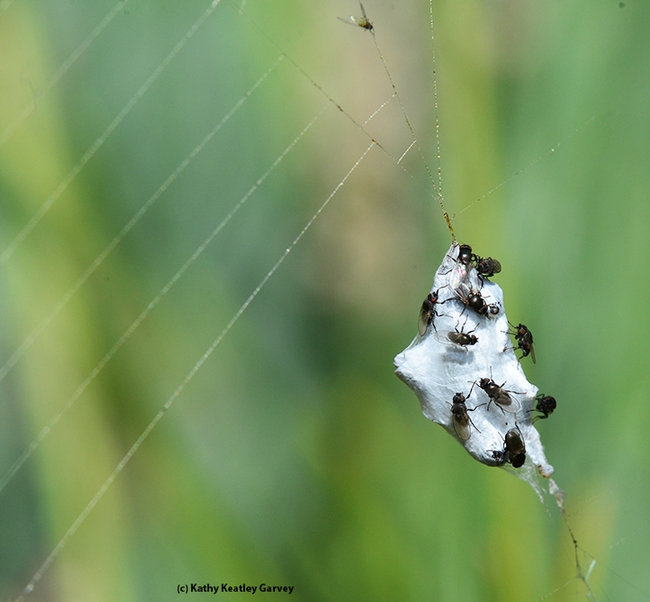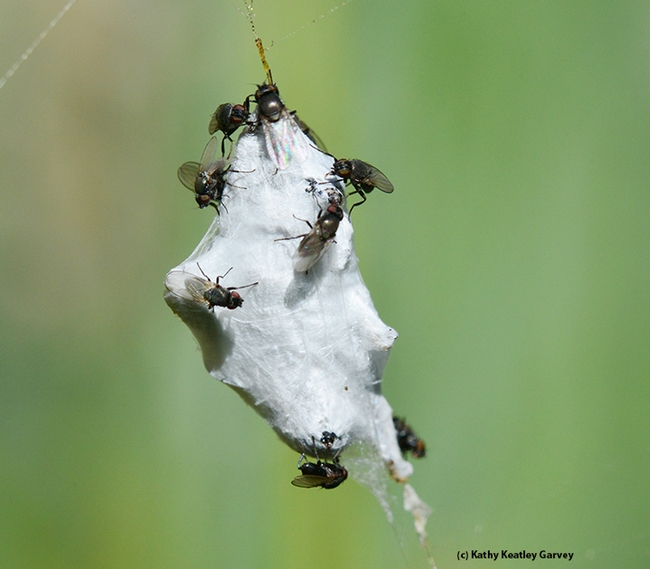- Author: Kathy Keatley Garvey
We have bright faces in our Vacaville, Calif., pollinator garden.
The bright faces are usually that of assorted bees and butterflies nectaring on members of the sunflower family: Mexican sunflower (Tithonia) and blanketflowers (Gaillardia).
But we did not expect to see this bright face: a banded garden spider, Argiope trifasciata. Bright face? Argiope is Latin for “with bright face” while trifasciata is Latin for “three-banded.”
The Argiope trifasciata spider is found throughout much of the United States and Canada. It's also in Central and South America, Australia, the Mediterranean region, Africa, Sri Lanka, the South Pacific Islands, and China, according to Spiders of North America, which informs us that scientists have identified a combined total of 4000 spider species in the United States and Canada.
Argiope trifasciata is just one of them, but what a beautiful spider it is. Clever and cunning, too.
It had crafted a web inches from the ground between a showy milkweed, Asclepias speciosa, and bluebeard (Caryopteris clandonensis) amid patches of Mexican sunflower patch and African blue basil.
Exactly where the bees are.
It snared two of them one morning and wrapped them for later consumption.
Meanwhile, an opportunistic and hungry freeloader fly, family Milichiidae and maybe genus Desmometopa, figured the spider ought to share its prey. It stopped to feed on the wrapped bee.
So, in actuality, there were two bright faces in the garden--the banded garden spider and the freeloader fly.
The faces of the wrapped honey bees--not so much.
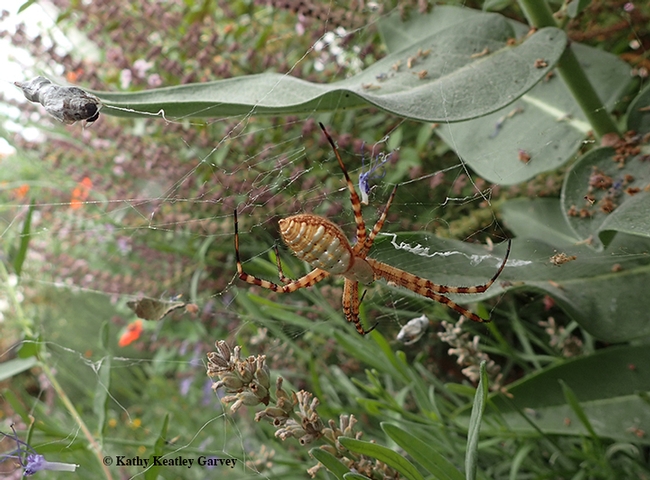
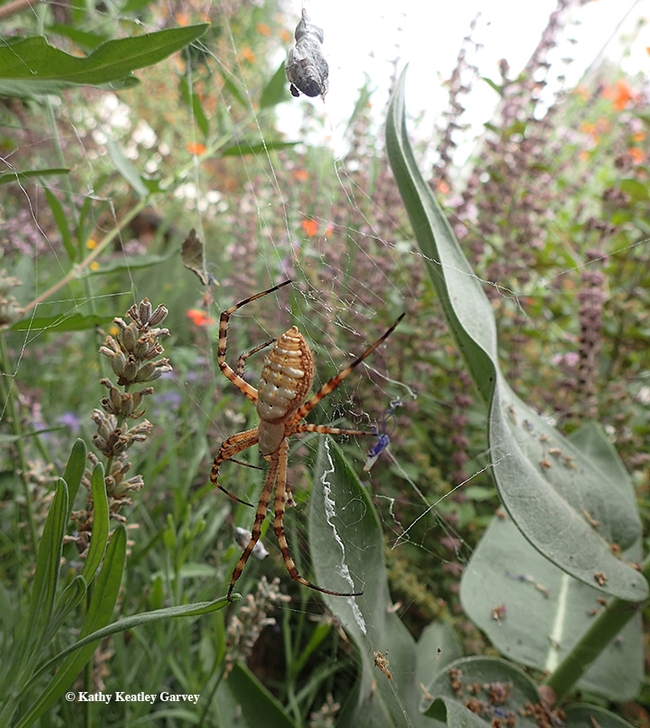
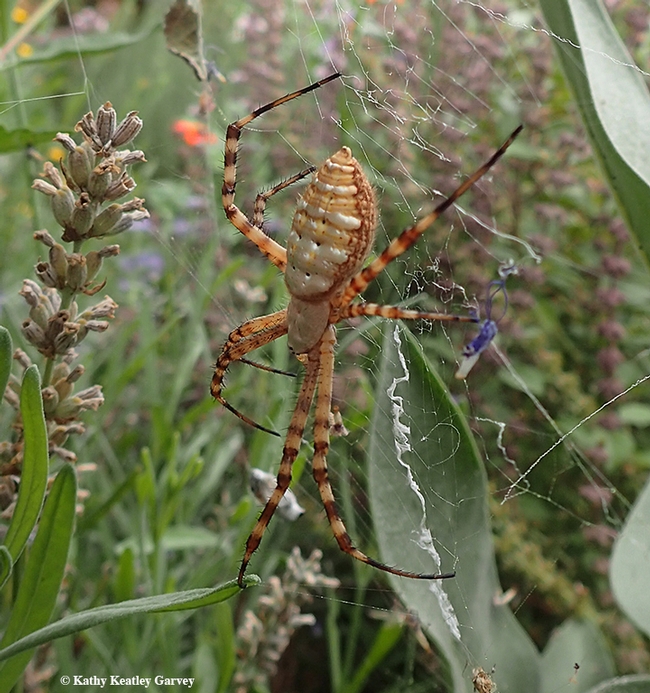
- Author: Kathy Keatley Garvey

Most of its prey are honey bees, sunflower bees or hover flies foraging in the nearby lavender.
One wrap, however, looked like it contained a huge black bee, the Valley carpenter bee. It was either that or a bumble bee!
We decided to find out. With a toothpick, we borrowed the prey from the spider (it already had 21 wrapped prey and wouldn't miss it).Taking a toothpick, we carefully pulled back the sticky silk cover.
Yes, it was a Valley carpenter bee (Xylocopa varipuncta), a female. The Xylocopa varipuncta females are solid black while the males are blond with green eyes. You've probably seen these bees buzzing around your yard or in a park. The largest bees in California, they're about an inch long. They're named the "Valley carpenter bee" because they're common in the Central Valley.
They're pollinators but some folks consider them pests. Using their mandibles, the females tunnel through wood, such as fence posts and telephone poles, to make their nests. They prefer untreated wood so if you varnish your wood, they'll probably look elsewhere. They do not ingest the wood. Sometimes they'll drill a hole in a dead or dying tree.
This one apparently couldn't exit the sticky web before the predator approached it and delivered its venomous bite.
Fortunately, it wasn't the yellow-faced bumble bee we've seen nectaring on the butterfly bush!



- Author: Kathy Keatley Garvey
Talk about greed. Talk about gluttony.
How much food does a banded garden spider (Argiope trifasciata) need?
For 30 minutes, we watched a well-fed banded garden spider catch bee after bee in its sticky web that it had cleverly anchored between two lavender plants. It's all about location, location, location! Go where the floral visitors are.
Then it would race toward the struggling bee or hover fly, inject its poisonous venom, and wrap it for later eating.
At last count, there were 20 spider-wrapped prey dangling in its pantry. Build it (a web) and they will come.
Seven deadly sins? Wrath, greed, sloth, pride, lust, envy and gluttony? Well, deadly for sure. A predator at work.
Then a smaller spider arrived on the scene and made the fatal mistake of engaging the resident spider. As soon as the intruder touched the banded garden spider, it, too, joined the trophy menagerie.
Another encounter, another prey, another wrap.
That's 21.
(Note: See more information on garden spiders on the University of California Statewide Integrated Pest Management (UC IPM) web site.)

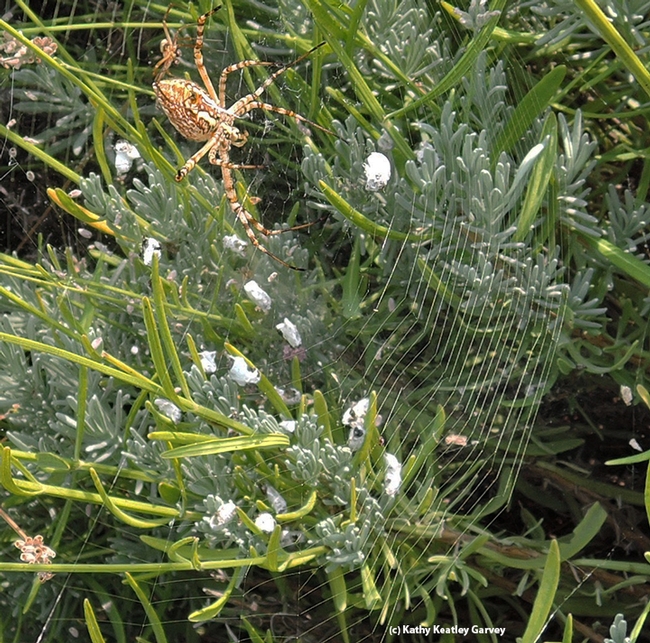

- Author: Kathy Keatley Garvey
If your dog is well, a little chunky, you're probably accustomed to someone saying "Fido never misses a meal, does he?"
Well, those little freeloader flies never miss a meal, either.
They not only never miss a meal, but they're never late for dinner. First come, first served. Table for 12, please.
Such was the case last weekend when a banded garden spider (Argiope trifasciata) trapped a bee in its web, wrapped it, and was all set to eat it.
Wait! Where did all those uninvited guests come from? (Family Milichiidae, and probably genus Desmometopa,)
The spider reluctantly abandons its prey.
"All right," the spider seems say. "Have at it. I'll get another one."

